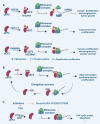Elongation factor 2 in cancer: a promising therapeutic target in protein translation
- PMID: 39707196
- PMCID: PMC11660736
- DOI: 10.1186/s11658-024-00674-7
Elongation factor 2 in cancer: a promising therapeutic target in protein translation
Abstract
Aberrant elongation of proteins can lead to the activation of oncogenic signaling pathways, resulting in the dysregulation of oncogenic signaling pathways. Eukaryotic elongation factor 2 (eEF2) is an essential regulator of protein synthesis that precisely elongates nascent peptides in the protein elongation process. Although studies have linked aberrant eEF2 expression to various cancers, research has primarily focused on its structure, highlighting a need for deeper exploration into its molecular functions. In this review, recent advancements in the structure, guanosine triphosphatase (GTPase) activity, posttranslational modifications, regulatory factors, and inhibitors of eEF2 are summarized. These findings provide a comprehensive cognition on the critical role of eEF2 and its potential as a therapeutic target in cancer. Furthermore, this review highlights important unanswered questions that warrant investigation in future research.
Keywords: Cancer; Elongation factor 2; Inhibitors; Protein elongation; Regulators.
© 2024. The Author(s).
Conflict of interest statement
Declarations. Ethics approval and consent to participate: Not applicable. Consent for publication: Not applicable. Competing interests: The authors declare no competing interests.
Figures







Similar articles
-
Eukaryotic elongation factor-2 (eEF2): its regulation and peptide chain elongation.Cell Biochem Funct. 2011 Apr;29(3):227-34. doi: 10.1002/cbf.1740. Epub 2011 Mar 10. Cell Biochem Funct. 2011. PMID: 21394738 Review.
-
Eukaryotic translation elongation factor 2 (eEF2) catalyzes reverse translocation of the eukaryotic ribosome.J Biol Chem. 2018 Apr 6;293(14):5220-5229. doi: 10.1074/jbc.RA117.000761. Epub 2018 Feb 16. J Biol Chem. 2018. PMID: 29453282 Free PMC article.
-
Brain-derived neurotrophic factor enhances the basal rate of protein synthesis by increasing active eukaryotic elongation factor 2 levels and promoting translation elongation in cortical neurons.J Biol Chem. 2009 Sep 25;284(39):26340-8. doi: 10.1074/jbc.M109.023010. Epub 2009 Jul 22. J Biol Chem. 2009. PMID: 19625250 Free PMC article.
-
The prohibitin-binding compound fluorizoline affects multiple components of the translational machinery and inhibits protein synthesis.J Biol Chem. 2020 Jul 17;295(29):9855-9867. doi: 10.1074/jbc.RA120.012979. Epub 2020 May 19. J Biol Chem. 2020. PMID: 32430400 Free PMC article.
-
Eukaryotic elongation factor 2 kinase confers tolerance to stress conditions in cancer cells.Cell Stress Chaperones. 2015 Mar;20(2):217-20. doi: 10.1007/s12192-014-0545-0. Epub 2014 Sep 24. Cell Stress Chaperones. 2015. PMID: 25248493 Free PMC article. Review.
Cited by
-
Label-Free Proteomic Profiling of the dvls2 (CL2006) Caenorhabditis elegans Alzheimer's Disease (AD) Model Reveals Conserved Molecular Signatures Shared With the Human AD Brain.J Neurochem. 2025 Jul;169(7):e70152. doi: 10.1111/jnc.70152. J Neurochem. 2025. PMID: 40653809 Free PMC article.
-
Licochalcone A suppresses pancreatic ductal adenocarcinoma progression by targeting eEF2K-mediated pyroptosis.Front Pharmacol. 2025 Jun 11;16:1595686. doi: 10.3389/fphar.2025.1595686. eCollection 2025. Front Pharmacol. 2025. PMID: 40567376 Free PMC article.
References
-
- Rodnina MV. Decoding and recoding of mRNA sequences by the ribosome. Annu Rev Biophys. 2023;52:161–82. - PubMed
Publication types
MeSH terms
Substances
Grants and funding
LinkOut - more resources
Full Text Sources
Medical
Miscellaneous

